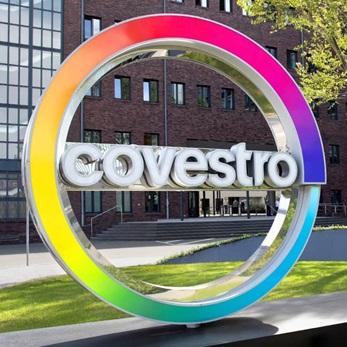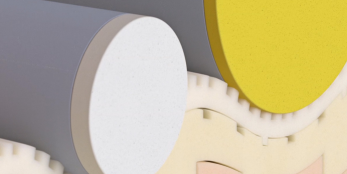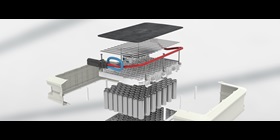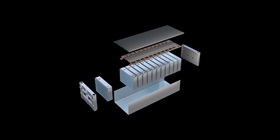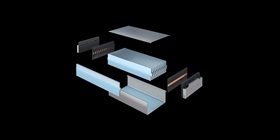Charging ahead with unexpected solutions: Bayblend® and Makrolon® grades for high-voltage components
Polycarbonates from Covestro offer excellent electrical properties that have been proven in a wide range of applications in the electrical industry. Today, due to current trends toward increasing energy density and reducing component size, electric vehicles (EVs) require increasingly more FR materials that provide a CTI of 600V (The CTI assesses the relative resistance of the insulating materials to tracking). It indicates the highest voltage at which no specimen fails when tested on five samples, each after the application of 50 drops of a defined test solution).
Traditionally, different thermoplastic classes provided this rating. Now Covestro combined the best of two material worlds, developing new solutions with UL94 V-0 flame retardancy rating and a maximum CTI of 600V according to IEC60112 combined with the valued properties of amorphous polycarbonates such as dimensional stability with low warpage and a thermally isotropic behavior, excellent ductility and stable mechanical and electrical properties vs. temperature.
These grades belong to our flame retardant Bayblend® and Makrolon® product line and are designed for applications in Li-ion-battery housings, high-voltage components of the electric powertrain and general E&E applications like EV charging stations and photovoltaics. Technical data sheets can be entered by clicking on the corresponding link in the ”related brands and products”-section of this page blow. UL Yellow Cards of Covestro materials can be found in the “related articles”-section at the very end of this page.
And there’s more.
Covestro has developed a tool box of different possibilities to increase the CTI of polycarbonates. For example, Covestro is able to support customers by developing new grades with additional thermally conductive properties for heat management in high-voltage applications which require an improved CTI (Covestro internal tests, preliminary data). More materials are in the product pipeline or can be developed according to customer requirements.
Bayblend® FR3015 CTI and Makrolon® FR6019 CTI available for Li-ion batteries, power electronics and other high-voltage applications
Bayblend® FR3015 CTI is a flame retardant and ductile PC blend, developed for Li-ion battery applications, such as cell holders or bus bar carriers. Characterized by a high Vicat temperature of 120°C this unreinforced and low warpage grade can be used for components with increased safety requirements, e.g. a CTI of 600V combined with a UL94V-0 rating at 1.5mm, in addition to the already available Bayblend® FR solutions. The high Vicat temperature results in stable mechanical properties over its entire temperature range, thus making glass-fiber reinforcement unnecessary.
Makrolon® FR6019 CTI is an unreinforced and flame-retardant polycarbonate with UL94V-0 classification at 1.5mm with a high CTI of 600V designed for applications in the power electronics and can also be used in Li-ion batteries. It is impact-resistant and has an even higher Vicat temperature of 130°C. Below the softening temperature, the mechanical properties remain nearly constant which again makes any glass-fiber reinforcement unnecessary. As a result, Makrolon® FR6019 CTI is distinguished by its thermally isotropic behavior and low warpage.
Both, Bayblend® FR3015 CTI and Makrolon® FR6019 CTI, are opaque grades and easy to color. Customers should bear in mind that the color, being part of the recipe, might modify the CTI value. Therefore, only these colors of Bayblend(R) FR3015 CTI and Makrolon(R) FR6019 CTI that can achieve a CTI of 600V according to IEC60112 are UL Yellow Card-recognized. For other colors, Covestro offers technical support. Positive results thereof will be continuously added to the UL Yellow Card.
Materials that measure up: tested according to IEC60112
The CTI is measured and rated according to IEC60112. Its result is a voltage rating of the tested material ranging between 175V and 600V. Depending on the rated voltage, the materials can be allocated to insulating material groups. Based on the CTI rating, the operating voltage and the degree of pollution, a minimum distance between tracks can be derived, which provides orientation to the design engineer.
The CTI test consists of two electrodes placed in a pre-defined distance on the substrate. Starting between 300 and 350V, at each voltage test level 50 drops of a conductive solution is applied between the electrodes. If a voltage level is successfully tested, it can be gradually increased until it reaches the maximum test voltage of 600V. If a voltage level failed in the test, the CTI is defined as the last voltage level having passed the test.
Range of materials options for low-voltage components
When it comes to thermal conductivity, metals typically outperform their thermally conductive plastic counterparts. But in terms of design or mass production, plastics surpass metals any time. By exploiting the advantages of plastics, an intelligent design of a plastic heat sink can often result in cooling performances similar to that of a metal heat sink.
In addition to Bayblend® FR3015 CTI and Makrolon® FR6019 CTI, both flame-retardant with a CTI of 600V, Covestro offers a wide portfolio of black, electrically conductive, and white, electrically insulating, thermally conductive plastics with a lower CTI. Some of these grades are equipped with an additional flame retardancy (FR) package yielding a UL94V-0 rating.
In order to achieve moderate heat dissipation, we recommend Makrolon® TC120 FR. It also has a low carbon footprint.
For higher heat dissipation rates, Makrolon® TC629 is the material of choice. Beside of being thermally conductive, Makrolon® TC629 provides electrical conductivity with a surface resistivity of 4∙103 Ω and a volume resistivity of 1∙102 Ωm. Due to these electrical properties, it provides an EMI shielding effectiveness of up to 55dB at 3mm thickness for frequencies ranging between 1 and 18GHz according to internal tests performed by Covestro (preliminary data, depending on part thickness and design). It could, therefore, support EMI shielding efforts at OEMs and tiers.
Beyond supplying materials, Covestro offers a wide range of support to help customers take their ideas from the drawing board to consumer driveways. This includes digital engineering, such as thermal simulations, structural simulations, rheological simulations and mold design support, as well as on-site processing and production support.
“Market knowledge and our own expertise were used to develop polycarbonates with low warpage, good ductility and temperature-dependent stable mechanical material behavior with new electrical properties. This enabled us to “combine the best of two material worlds”.“
Key Benefits
- Electrical creepage resistance and burning behavior: UL94 V-0 at 1.5 mmand a CTI rating of 600V acc. to IEC60112
- Dimensional stability: Low & predictable shrinkage, low warpage
- Impact resistance: Excellent ductility without glass fiber reinforcement
- Mechanical behavior: Almost constant mechanical properties over a wide temperature range in combination
- Electrical properties: Almost constant electrical strength and volume resistance over a wide temperature range

